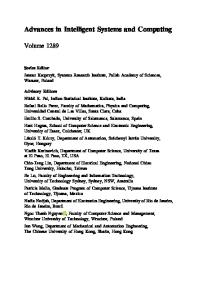Mixed-Ionic-Electronic-Conduction (MIEC)-Based Access Devices for 3D Multilayer Crosspoint Memory
- PDF / 5,342,033 Bytes
- 12 Pages / 612 x 792 pts (letter) Page_size
- 19 Downloads / 289 Views
Mixed-Ionic-Electronic-Conduction (MIEC)-Based Access Devices for 3D Multilayer Crosspoint Memory Kumar Virwani, Geoffrey W. Burr, Pritish Narayanan, and B¨ ulent Kurdi IBM Research – Almaden, 650 Harry Road, San Jose, California 95120 [email protected] ABSTRACT A number of applications call for the organization of resistive non-volatile memory (NVM) into large, densely-packed crossbar arrays. While resistive-NVM devices often possess some degree of inherent nonlinearity (typically 3-30× contrast), the operation of large (>1000×1000 device) arrays at low power tends to require large (> 1e7) ON-to-OFF ratios between the currents passed at high and at low voltages. Such large nonlinearities can be implemented by including a distinct access device together with each of the state-bearing resistive-NVM elements. While such an access device need not store data, its list of requirements is almost as challenging as the specifications demanded of the memory device. We review our work on high-performance access devices based on Cu-containing Mixed-IonicElectronic Conduction (MIEC) materials [1–7]. (This version focuses only on the MIEC-based access device itself; previously-published longer versions of this work [8–10] also include more extensive surveys of competing devices as well.) These devices require only the low processing temperatures of the Back-End-Of-the-Line (BEOL), making them highly suitable for implementing multi-layer crossbar arrays. MIEC-based access devices offer large ON/OFF ratios (>1e7), a significant voltage margin Vm (over which current < 10nA), and ultra-low leakage ( 50 MA/cm2 ) [1].
Current
½Vm + 120mV ½Vm + 60mV
(a) half-select ( h ll ) un-select (shallow) l t
Current
(b)
½Vm ((= 520mV))
(deep)
½Vm – 180mV ½Vm – 300mV Voltage [V]
un-select
Time [hours]
Time [seconds]
Figure 4 MIEC-based access devices maintain (a) ultralow-leakage over hours of exposure, whether in a deep (±230mV) or shallow un-select (±350mV) condition, and even (b) repeated 2sec exposures to half-select (±530mV) and even higher bias conditions has minimal impact on subsequent leakage, all highly inconsistent with filamentary operation [5].
MIEC-based access devices, similar to the way CB-RAM [24] and even some memristive [25] nonvolatile memory devices are known to operate. However, our extensive experimental evidence does not support this hypothesis at all. The turn-ON of symmetric MIEC-based access devices (Figure 2(a)) does not exhibit filamentary behavior [2], and devices clearly show area-scaling of current over a wide range of electrode sizes (Figure 3) [1]. The long-term repeatability and stability of MIEC-based access devices over a wide range of currents (Figure 4) is also highly inconsistent with a filamentary role [5]. However, the I-V characteristics of highly asymmetric devices — such as the devices shown in (Figure 2(b)) which have a Top Electrode Contact that is much larger (TEC >3um diameter) than its Bottom Electrode Contact (BEC ∼ 80nm) — do illustrate that filament formation can occur in this mate
Data Loading...











